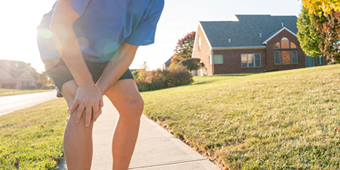- Bone and Joint Health
- Foot and Ankle
- Hand and Wrist
- Health Topics
- Joint Conditions/Injuries/Treatment
- Joint Pain/Pain Management
- Osteoarthritis
- Shoulder
Tendinitis, Tendinosis: Both a Pain, But Different

Answer a few questions and we'll provide you with a list of primary care providers that best fit your needs.
Tendinitis. Tendinosis.
Both of these similarly named conditions involve painful tendons – the tough, flexible bands of tissue that connect muscles to bones. For instance, in the thumb, shoulder, elbow, wrist, hip, knee – or Achilles tendon, which connects the calf muscle to the heel bone.
But beyond the pain they can put you through, the similarity of tendinitis and tendinosis ends. A key distinction: They require different courses of treatment.
Determining which condition troubles you – tendinitis or tendinosis – will enable your health care provider to prescribe the appropriate treatment.
Here’s how the conditions differ and how they’re treated:
What Is Tendinitis?
Tendinitis is an inflammation or swelling of a tendon. The inflammation of tendinitis results from overuse of a tendon in repetitive motions in work or athletic activity – or from a sudden force or impact to the tendon. For instance, when picking up a heavy object or load.
This stress creates micro-tears in the affected tendon, leading to inflammation and swelling.
Examples of activities that can lead to tendinitis include:
- Outdoor work such as gardening, shoveling, and raking
- Work tasks, from typing and clicking a mouse to using power tools and painting
- Housecleaning activities, such as scrubbing
- Sports, such as tennis, golf, throwing and pitching, and skiing
Poor posture or poor stretching and conditioning before exercise or other physical activity can increase your risk of tendinitis.
How Is Tendinitis Treated?

When you have tendinitis, the structure of your tendon is not damaged. Instead, the tendon becomes inflamed and may swell. The recommended course of treatment is to rest the affected tendon and joint to prevent chronic injury and damage to the tendon. Your health care provider may also have you take over-the-counter non-steroidal anti-inflammatory drugs (NSAIDs) to relieve the inflammation and swelling. NSAIDs include ibuprofen (Motrin, Advil) and naproxen (Aleve, Naprosyn).
Typically, you can recover from tendonitis in several days to six weeks.
Other treatment may include:
- Physical therapy and exercises to strengthen the tendons and muscles and preserve range of motion
- A splint, brace, or orthotics to aid in your therapy
- Injections of corticosteroids (powerful anti-inflammatory medications) to help relieve swelling and pain
While tendinitis is a common problem, research shows that people commonly think they have tendinitis when they really have tendinosis.
What Is Tendinosis?
With tendinosis, a tendon shows no signs of inflammation. Rather, tendinosis results in a degeneration or breakdown of the tendon’s collagen – the primary structural protein of skin, tendons, and other connective tissue. This degeneration results from chronic, continued overuse without rest to permit healing.
Growth of abnormal blood vessels and thickening of the tendon’s covering, or sheath, may accompany the deterioration of collagen.
Even tiny repetitive movements, such as typing and clicking a mouse, can lead to tendinosis.
While tendinitis involves inflammation and swelling of a tendon, it causes no damage or degeneration of the tendon like tendinosis does.
This difference leads to differences in treatment.
Determining which condition troubles you – tendinitis or tendinosis – will enable your health care provider to prescribe the appropriate treatment.
How Is Tendinosis Treated?
Typically, NSAIDs are not prescribed for tendinosis, because the condition involves no inflammation – and NSAIDs inhibit collagen growth, which is a key to tendon healing.
When diagnosed at an early stage, tendinosis can be treated in six to 10 weeks. But once it reaches a chronic stage, treatment can take three to six months. And in many cases, the chance of recovery is limited, with the primary goal being to prevent the condition from worsening and a tendon rupturing, which could require surgery.
Other goals of treatment for tendinosis include promoting production of new collagen to strengthen the affected tendon, eliminate or decrease pain, increase strength and increase range of motion.
Treatment and maintenance of tendinosis may include:
- Rest. If you’re involved in repetitive work, your health care provider may recommend taking a one-minute break every 15 minutes and a five-minute break every 20 to 30 minutes. You may need to rest more at the beginning of treatment. And if an activity causes you pain, you’re probably overdoing it – and need to rest.
- Ice. Apply for 15 to 20 minutes several times a day and after using the affected tendon.
- Bracing or taping. Do this as recommended by your physical therapist, to reduce stress on the tendon
- Change how you work. For instance, if you use a computer, be sure your wrists rest in a neutral position while typing, to prevent stress on tendons. A physical therapist can help you make ergonomic adjustments to relieve your tendons and reduce your risk of other musculoskeletal disorders.
- Light stretching. This will help you preserve range of motion and flexibility, reduce tension on the affected tendon, and increase circulation, to promote healing.
- Eccentric weight training. This can strengthen muscles to reduce stress on tendons, as well as stimulate collagen production. To minimize your risk of injury and maximize benefits, consult with your health care provider or physical therapist before starting.
- Massage. This can stimulate circulation and promote collagen development to restore weakened tendons. Deep massage can also reduce pain and increase strength and mobility.
- Nutrition. Ask your health care provider or a nutrition specialist for recommendations on changes to your diet to promote collagen production and improved tendon health. Nutrients linked to tendon health include vitamin C, manganese, zinc, vitamin B6, and vitamin E.
Answer a few questions and we'll provide you with a list of primary care providers that best fit your needs.
Source: National Institute of Health; DifferenceBetween.info; Innerbody.com




